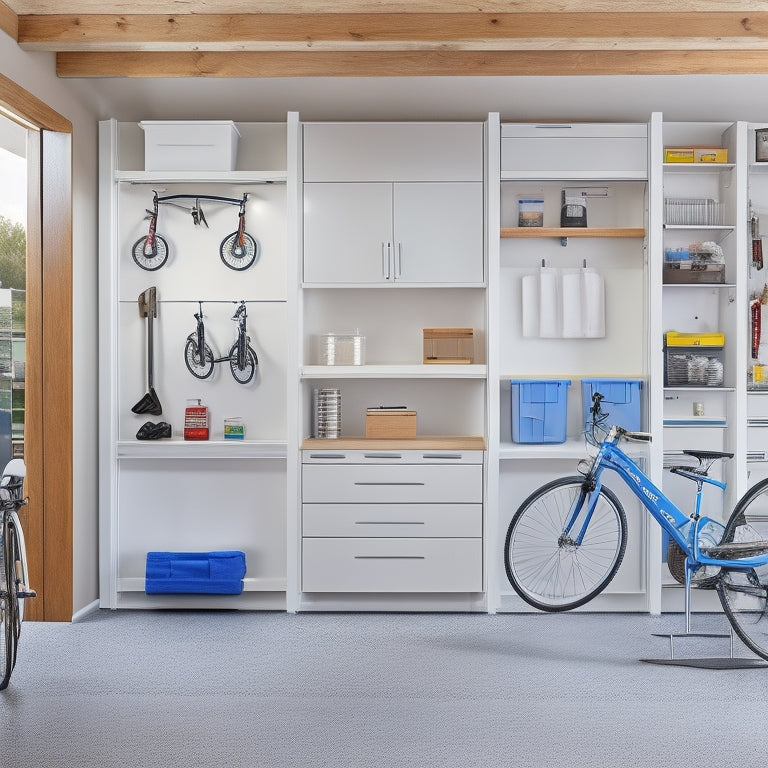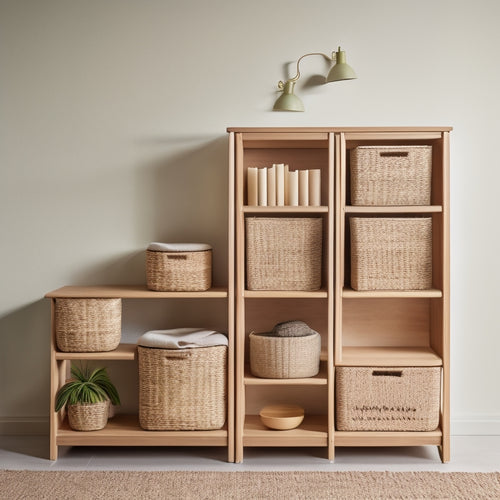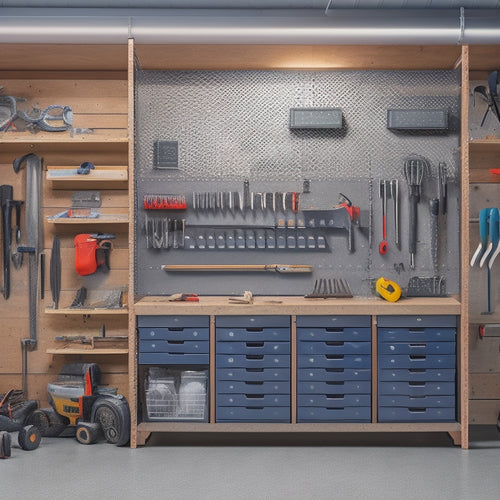
Building Budget-Friendly Garage Storage Cabinets
Share
You're about to create a budget-friendly garage storage cabinet system that makes the most of your space. Start by evaluating your garage's dimensions, identifying obstacles, and categorizing items by usage. Next, choose affordable materials like OSB or MDF, and use cost-effective finishes. Design a layout that maximizes storage and accessibility, considering wall-mounted cabinets, adjustable shelves, and a mix of open and closed storage. With a clear plan, you can build sturdy frames, install shelves, and add doors and hardware. Now, take the next step to change your cluttered garage into a well-organized haven.
Key Takeaways
- Assess your garage's space and categorize items to determine the optimal cabinet design and material choices for your needs and budget.
- Choose affordable materials like OSB, MDF, and reclaimed wood, and opt for cost-effective finishes like laminate, paint, or stain.
- Design cabinets with adjustable shelves, wall-mounted frames, and a mix of open and closed storage to maximize space and accessibility.
- Build frames and shelves with precision cutting, square assembly, and sturdy shelf supports, following safety guidelines and tutorials if necessary.
- Install cabinets at ergonomic heights, ensure stability and secure fastening, and consider labeling systems and zoning strategies for efficient organization.
Assessing Your Garage Storage Needs
About 80% of garages are cluttered, and yours is likely no exception. Before you start building your budget-friendly garage storage cabinets, take the time to assess your garage storage needs.
Start by evaluating the space you have available. Measure the length, width, and height of your garage, and identify any obstructions, such as windows, doors, or pipes. Consider the types of items you need to store, including tools, sports equipment, and seasonal decorations.
Next, categorize the items you want to store into groups, such as "frequently used," "occasionally used," and "rarely used." This will help you determine the types of cabinets and shelves you need.
Think about the size and shape of the items, as well as any special requirements, such as ventilation or protection from the elements. By taking the time to evaluate your space and categorize your items, you'll be able to design a storage system that meets your specific needs and keeps your garage organized and safe.
Choosing Affordable Cabinet Materials
When it comes to building budget-friendly garage storage cabinets, the materials you choose can make all the difference in staying within your budget.
To keep costs down, consider the following affordable cabinet materials:
-
Plywood alternatives: Instead of using expensive plywood, look for cheaper alternatives like oriented strand board (OSB) or medium-density fiberboard (MDF). These options are durable and can withstand the weight of your stored items.
-
Budget-friendly lumber: Opt for less expensive types of lumber, such as pine or fir, for the cabinet frames and shelves. You can also use reclaimed or recycled wood to save money and reduce waste.
-
Cost-effective finishes: Choose budget finishes like laminate, paint, or stain to give your cabinets a finished look without breaking the bank. These options are easy to apply and can be customized to match your garage's style.
Designing Your Cabinet Layout
Your garage storage cabinets' layout is essential to maximizing storage space and accessibility. When designing your cabinet layout, consider the items you'll be storing and how you'll access them. This will help you determine the ideal cabinet size, shape, and configuration.
To enhance space, think vertically and use wall-mounted cabinets to keep floors clear. Install adjustable shelves to accommodate items of varying sizes. Consider a mix of open and closed storage to keep frequently used items accessible while keeping less frequently used items hidden from view.
Don't forget about cabinet design aesthetics. Choose a style that complements your garage's décor and consider adding decorative trim or hardware to give your cabinets a finished look.
Measure your garage carefully to guarantee your cabinets fit snugly and make the most of available space. By incorporating space enhancement strategies and cabinet design aesthetics into your layout, you'll create a functional and visually appealing storage solution that meets your needs and enhances your garage's overall look.
Building Cabinet Frames and Shelves
Efficiency is key when building cabinet frames and shelves, as it sets the foundation for a functional and organized garage storage system.
You'll want to verify your frame construction is sturdy and can support the weight of your stored items.
To build your cabinet frames, you'll need to:
-
Cut your frame pieces: Use a miter saw or circular saw to cut your 2x2 or 2x4 lumber into the required pieces for your frame.
-
Assemble the frame: Use wood screws or nails to assemble the frame, making sure it's square and level.
-
Attach shelf supports: Install shelf supports, such as adjustable shelf pins or fixed shelf brackets, to provide a solid base for your shelves.
When building your shelves, consider using 3/4-inch plywood or MDF for added strength and durability.
Always follow safety guidelines when working with power tools, and consider consulting online tutorials or woodworking guides if you're new to frame construction and shelf support installation.
Adding Doors and Hardware Finishing
You'll now need to attach doors to your cabinet frames using a secure installation method, such as hinges or slides, to guarantee they open and close smoothly.
Next, choose hardware options that fit your style and budget, from modern handles to rustic knobs.
Door Installation Methods
Framed openings await the installation of doors, which not only conceal stored items but also enhance the garage's overall aesthetic.
You've chosen your door style, now it's time to focus on the installation techniques.
-
Recessed Mount: This method involves attaching the door to the frame using hinges that are recessed into the cabinet's side panel. This creates a flush surface when the door is closed.
-
Surface Mount: With this technique, the hinges are attached to the outside of the cabinet's side panel, creating a more industrial look. Confirm the hinges are sturdy to support the door's weight.
-
Soft-Close: For a more premium feel, consider installing soft-close hinges that slow the door's closure, preventing slamming and reducing wear and tear.
When installing doors, prioritize safety by verifying they're securely attached and won't fall off or pinch fingers.
Choose installation techniques that suit your door style and cabinet design. By following these methods, you'll create a functional and visually appealing garage storage cabinet.
Choosing Hardware Options
With your doors securely installed, it's time to focus on the hardware that completes the look and functionality of your garage storage cabinets.
You'll need to choose hardware that fits your budget and meets your storage needs. There are various hardware types to take into account, including knobs, handles, and slides.
Knobs and handles come in different materials, such as metal, wood, or plastic, and can be installed on the doors or drawers. Slides, on the other hand, allow you to easily open and close the drawers.
When selecting hardware, keep in mind the weight capacity of the slides and the durability of the knobs or handles. Budget considerations are vital, so set a price range and stick to it.
You can find affordable options at hardware stores or online. Remember to check the warranty and return policy before making a purchase.
Adding Soft-Close Features
Take your garage storage cabinets to the next level by incorporating soft-close features, which guarantee a smooth and quiet closure every time.
This upgrade is especially important in a garage, where loud noises can be startling and even alarming. By installing soft-close mechanisms, you'll enjoy a peaceful and safe environment.
To achieve this, consider the following:
-
Soft-close drawer slides: These replace traditional drawer slides and guarantee that your drawers close slowly and quietly. They're usually easy to install and require minimal adjustments.
-
Soft-close door hinges: These hinges slow down the door's closure, reducing noise and preventing slamming. They're a great option for cabinets with doors that are frequently opened and closed.
-
Soft-close latches: These latches catch the door or drawer as it closes, slowing it down and preventing loud bangs. They're often used in conjunction with soft-close hinges or slides.
Installing and Organizing Cabinets
Behind the garage door, a clutter-free oasis awaits, and it starts with properly installing and organizing your storage cabinets. You've chosen the perfect cabinets style, and now it's time to put them to use.
Begin by planning the layout of your storage solutions. Measure your available wall space and consider the items you need to store. Install your cabinets at a comfortable height to avoid straining your back when accessing contents.
Use wall anchors to secure your cabinets, ensuring they're stable and won't topple over. Organize your cabinets by categorizing items into zones, such as tools, sports equipment, and seasonal decorations.
Label each cabinet and shelf to maintain visibility and ease of access. Install adjustable shelves or dividers to maximize storage capacity and customize your space.
Frequently Asked Questions
Can I Use Reclaimed Wood for My Garage Storage Cabinets?
You can use reclaimed wood for your project, but make certain you're aware of its benefits, like unique character and eco-friendliness, and source it responsibly to avoid potential safety hazards, like lead paint or termite damage.
How Do I Ensure My Cabinets Are Rodent-Proof?
As you fortify your sanctuary against unwanted invaders, remember that a rodent-proof fortress begins with careful planning. Seal all cracks, use rodent-deterrent materials, and design cabinets with pest control in mind, ensuring a safe haven for your belongings.
Are There Any Local Building Codes I Should Follow?
You'll need to check with your local government to see if permits are required for your project, making certain you comply with safety regulations, such as electrical and fire codes, to avoid costly fines and guarantee a safe build.
Can I Build Cabinets With Adjustable Shelves?
You can build cabinets with adjustable shelves by incorporating a modular cabinet design, using shelf materials like sturdy metal brackets or wooden dowels, and guaranteeing secure installation to prevent collapse and guarantee safe storage.
How Do I Prevent Moisture Buildup in My Cabinets?
Like a medieval knight shielding his armor from the elements, you'll want to defend your cabinets from moisture buildup by incorporating moisture barriers and ventilation solutions, ensuring air circulates and humidity is kept at bay, safeguarding your stored treasures.
Conclusion
You've built budget-friendly garage storage cabinets that are both functional and affordable. You've assessed your storage needs, chosen affordable materials, designed a layout that maximizes space, constructed sturdy frames and shelves, added doors and hardware, and finished with a flourish. Now, install and organize your cabinets to create a garage that's tidy, efficient, and ready to tackle any project that comes your way.
Related Posts
-

Open Storage Bins for Shelving Units
You need open storage bins that integrate seamlessly with your shelving units to boost your organization, productivit...
-

Building a Wall Tool Storage System
You're about to create a customized wall tool storage system that streamlines your workflow. Start by clearing your w...
-

Best Tool Hooks for Garage Organization
When choosing the best tool hooks for your garage organization, you'll want to evaluate factors like weight capacity,...


